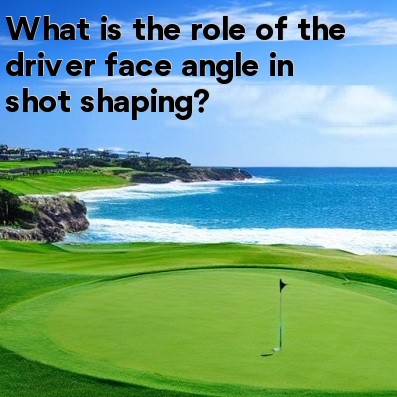
In golf, the role of the driver face angle in shot shaping
When it comes to shot shaping in golf, one of the crucial factors that can greatly influence the direction and trajectory of the ball is the driver face angle. The driver face angle refers to the position of the clubface at impact and can impact whether the ball curves to the right (fade) or to the left (draw). Let's dive deeper into understanding the role of the driver face angle in shot shaping.
- Open face angle for a fade: When the driver face is open at impact, it means that the clubface is pointing slightly to the right of the target for right-handed golfers. This open face angle promotes a fade shot, which is a controlled shot that curves gently from left to right. The fade shot is highly advantageous as it allows golfers to navigate obstacles and avoid trouble on the course.
- Closed face angle for a draw: On the other hand, when the driver face is closed at impact, it means that the clubface is pointing slightly to the left of the target for right-handed golfers. This closed face angle promotes a draw shot, which is a controlled shot that curves gently from right to left. The draw shot is often preferred by golfers as it allows for increased distance and can be helpful in certain situations such as minimizing the impact of windy conditions.
- Neutral face angle for a straight shot: A neutral face angle is when the clubface is square to the target at impact. This position gives the golfer the best chance of hitting a straight shot. A straight shot is desirable when playing on a course with few obstacles and when accuracy is of utmost importance.
However, it's important to note that the driver face angle is just one factor among many that can affect shot shaping. Other factors such as swing path, clubhead speed, and clubface contact point also play crucial roles. Achieving the desired shot shape requires a combination of these factors working together harmoniously.
It's worth mentioning that adjusting the driver face angle is not something that can be done easily during a golf swing. Instead, it requires careful setup and club selection. Golfers often choose drivers with adjustable features that allow them to manipulate the face angle to their preference. By experimenting with different face angles during practice sessions, golfers can discover their optimal settings to consistently achieve the desired shot shape.
In conclusion, the driver face angle is an important element in shot shaping. Depending on whether the face angle is open, closed, or neutral at impact, golfers can produce shots that fade, draw, or go straight. Understanding how the driver face angle influences shot shape can assist golfers in strategizing their shots and adapting to different course conditions. By mastering the art of shot shaping, golfers can add a new dimension to their game and tackle challenging course layouts with confidence.





